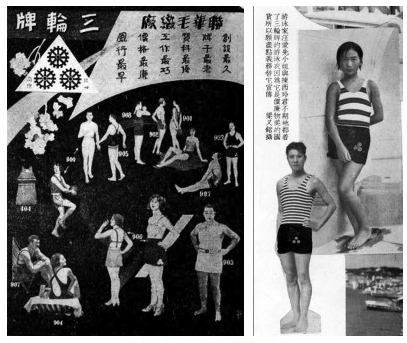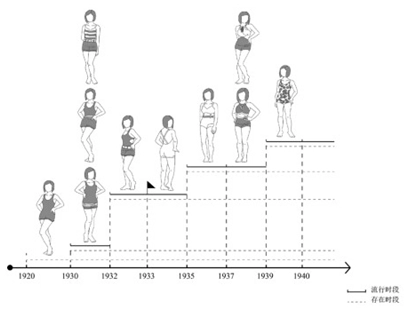The Prevalence of Printed Swimwear in Shanghai in 1940 (Part Two)
In addition to new styles, new materials are also a focus. In the 1920s, swimsuits were mainly made of knitted wool. In 1933, "Small World: Pictorial Bimonthly" published the rubber swimsuit that was popular abroad. In 1935, "Good Friend" once again introduced rubber swimsuits, saying that The United States advocates the fanaticism of novelty. The women's swimsuit published in New York in 1935 was no longer woven with wool as before, but a very thin rubber. It is made with various patterns and ingenious styles." "From the 1910s to the 1940s, various new materials were used in manufacturing swimsuits, such as glass, wood, and melted leather. In 1946, The article "Secrets Open" in "Universal Glass" published in the inaugural issue of "Treasures of the World" stated that American women like to use glass socks, underwear, bras, and handbags. Recently, the glass swimsuits in the market had new styles and were colorful. Shanghai already had glass socks and handbags, and soon, shoes and swimwear would follow.
Although there is always the latest information from various countries, the popularity of new swimsuits in China during the Republic of China generally lagged for 2 to 3 years. For example, in 1927, the Picture Times introduced the new American women's swimsuit, which was a striped top and decorated with a belt, but the style didn't become popular in China until 1930. Another example was the split swimsuit, which became popular in the United States in 1930. In 1932, the 835th issue of "Picture Times" published a photo titled "The latest American swimsuit with only the cloth covering the breast", like a middle-aged woman wearing a split swimsuit, and the top was similar to bras, with thin straps and a low V-neck. However, similar styles became popular in China until 1935. As for the material of swimsuits, although there have been new materials since the mid-1930s, knitted wool was still the most important material in China during the Republic of China. "Diyang" was a famous wool brand at that time.
For these fashionable swimsuits, there are three main ways for women in the Republic of China to obtain them. First, they directly bought foreign ready-made clothes. In 1927, "China Film Magazine" published advertisements for new American swimsuits, and indicated the price. Second, they bought swimsuits made in China. The well-known brand at that time was the Sanlun from Lianhua Woollen Factory. Judging from its advertisements, the swimsuits were of various styles and kept up with the latest trends. The images of celebrities from all walks of life wearing Sanlun swimsuits were often seen in newspapers and magazines (Figure 20). Third, the swimsuit was self-made. There were often teaching examples of swimsuit knitting in newspapers and magazines, often with foreign styles as teaching examples. Generally, photos of ready-to-wear swimsuits were published, and then each part was explained; materials, sizes and weaving techniques were marked one by one.
To sum up, we can know the trend of women's swimsuit styles in the Republic of China (Figure 21). Beginning in the mid-to-late 1920s, images of Chinese women wearing swimsuits appeared in major newspapers and magazines one after another. The style of swimsuits in this period was relatively simple, and the representative was the one-piece vest and culottes. This style has also become a classic style of women's swimsuits in the Republic of China, which continued till the 1940s. Belts and stripes were the two basic popular elements of women's swimwear in the 1930s. Between 1930 and 1932, one-piece swimsuits with striped vests and belts were the most common styles. At the same time, swimsuits showing the shoulder and waist brought some new ideas to the changes in swimsuit structure. 1933 to 1935 was a turning point for swimsuit styles. In 1933, the backless swimsuit trend emerged, which lasted for a long time and had many styles. Split swimsuits became popular in 1935, and from 1937 to 1939, halterneck split swimsuits became the new favorite of celebrities and socialites. In the 1940s, the styles of swimsuits had become more diversified, and printing patterns with good decorative effects were popular; the printing theme was mainly plants and flowers.

Figure 20 The advertisement for Sanlun swimsuits
Among the eastern and western countries, the United States has the greatest influence on the fashion of women's swimsuits in the Republic of China. The main source of information for the public is newspapers and magazines, which are mainly divided into four themes to introduce new styles and new materials of swimsuits. Women's swimsuit fashion in the Republic of China followed the popular trajectory of the United States, but in terms of time, the popularity of new styles in China is generally about 2 to 3 years later. From the perspective of clothing acquisition channels, in addition to directly purchasing European and American swimsuits, China has professional brands of swimwear ready-to-wear weaving, as well as professional brands of swimwear materials. The public can buy domestic swimwear or weave them by themselves.

Figure 21 Changes in styles of women's swimsuits in the Republic of China
Although there is always the latest information from various countries, the popularity of new swimsuits in China during the Republic of China generally lagged for 2 to 3 years. For example, in 1927, the Picture Times introduced the new American women's swimsuit, which was a striped top and decorated with a belt, but the style didn't become popular in China until 1930. Another example was the split swimsuit, which became popular in the United States in 1930. In 1932, the 835th issue of "Picture Times" published a photo titled "The latest American swimsuit with only the cloth covering the breast", like a middle-aged woman wearing a split swimsuit, and the top was similar to bras, with thin straps and a low V-neck. However, similar styles became popular in China until 1935. As for the material of swimsuits, although there have been new materials since the mid-1930s, knitted wool was still the most important material in China during the Republic of China. "Diyang" was a famous wool brand at that time.
For these fashionable swimsuits, there are three main ways for women in the Republic of China to obtain them. First, they directly bought foreign ready-made clothes. In 1927, "China Film Magazine" published advertisements for new American swimsuits, and indicated the price. Second, they bought swimsuits made in China. The well-known brand at that time was the Sanlun from Lianhua Woollen Factory. Judging from its advertisements, the swimsuits were of various styles and kept up with the latest trends. The images of celebrities from all walks of life wearing Sanlun swimsuits were often seen in newspapers and magazines (Figure 20). Third, the swimsuit was self-made. There were often teaching examples of swimsuit knitting in newspapers and magazines, often with foreign styles as teaching examples. Generally, photos of ready-to-wear swimsuits were published, and then each part was explained; materials, sizes and weaving techniques were marked one by one.
To sum up, we can know the trend of women's swimsuit styles in the Republic of China (Figure 21). Beginning in the mid-to-late 1920s, images of Chinese women wearing swimsuits appeared in major newspapers and magazines one after another. The style of swimsuits in this period was relatively simple, and the representative was the one-piece vest and culottes. This style has also become a classic style of women's swimsuits in the Republic of China, which continued till the 1940s. Belts and stripes were the two basic popular elements of women's swimwear in the 1930s. Between 1930 and 1932, one-piece swimsuits with striped vests and belts were the most common styles. At the same time, swimsuits showing the shoulder and waist brought some new ideas to the changes in swimsuit structure. 1933 to 1935 was a turning point for swimsuit styles. In 1933, the backless swimsuit trend emerged, which lasted for a long time and had many styles. Split swimsuits became popular in 1935, and from 1937 to 1939, halterneck split swimsuits became the new favorite of celebrities and socialites. In the 1940s, the styles of swimsuits had become more diversified, and printing patterns with good decorative effects were popular; the printing theme was mainly plants and flowers.

Figure 20 The advertisement for Sanlun swimsuits
Among the eastern and western countries, the United States has the greatest influence on the fashion of women's swimsuits in the Republic of China. The main source of information for the public is newspapers and magazines, which are mainly divided into four themes to introduce new styles and new materials of swimsuits. Women's swimsuit fashion in the Republic of China followed the popular trajectory of the United States, but in terms of time, the popularity of new styles in China is generally about 2 to 3 years later. From the perspective of clothing acquisition channels, in addition to directly purchasing European and American swimsuits, China has professional brands of swimwear ready-to-wear weaving, as well as professional brands of swimwear materials. The public can buy domestic swimwear or weave them by themselves.

Figure 21 Changes in styles of women's swimsuits in the Republic of China